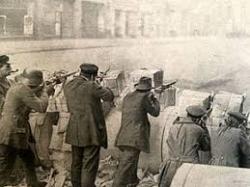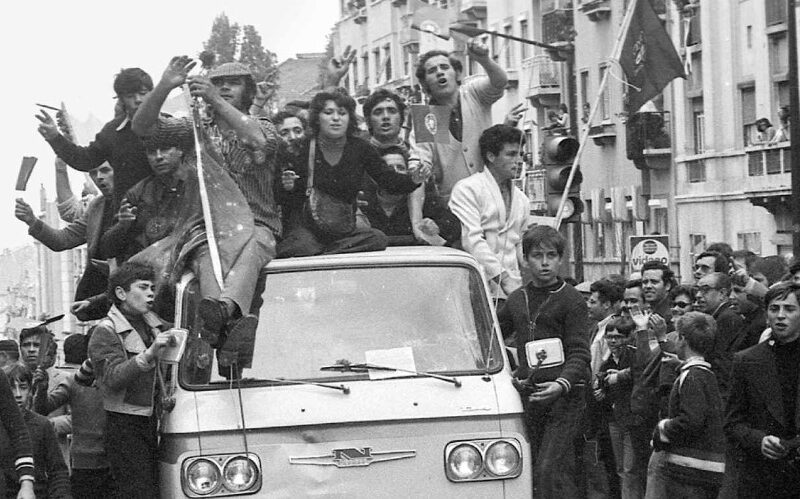November 11th this year will mark the one hundredth anniversary of the declaration of the armistice that ended the slaughter of the First World War. What will not be marked in the national press, of course, is the fact that it was the revolutionary mood of the working class in Europe and the increasing disaffection among the troops that made an armistice inevitable at some point. Not only did the Russian working class take power in October 1917, taking Russia effectively out of the war, but days before the official armistice, the mighty German working class moved to emulate their brothers and sisters in Russia. It was a great tragedy for the German and European working class that this German revolutionary movement, although it succeeded in removing the Kaiser, was not successful in putting the working class in power, as it had been in Russia. We reprint here an article first published in 1993, outlining the great events in Germany in those fateful weeks.
by Dave Cartwright, Glasgow North West Labour Party
The outbreak of the German revolution in November 1918 was of enormous significance for the world working class, following on from the Russian Revolution of 1917. Lenin and Trotsky always saw the Russian revolution as the first step in a world movement. If the German working class had succeeded in taking power, it would have provided an enormous boost to workers fighting to free themselves from the horrors of capitalism in other countries, especially in Europe. Unfortunately, the German Revolution was derailed, primarily by the leaders of the Social Democrats (SPD). But the revolution shows that the powerful German working class can look back confidently at its own history and tradition of revolutionary struggle.
“The day of the revolution has arrived. We have achieved freedom … We now proclaim the free socialist republic of Germany”, Karl Liebknecht told a mass demonstration of workers and soldiers in Berlin on 9th November 1918. That month saw the outbreak of a massive revolutionary movement of the German workers, soldiers and sailors. If this movement had led to the workers to taking power, then the whole future of mankind would have changed in favour of world socialism.
The events of November 1918 showed the deep-seated anger and frustration that had been building up in Germany during the war. The movement did not just appear out of the blue. It was the culmination of years of growing discontent. Although there was widespread support for the war at the beginning, this eventually started to wane. In 1916 there was an important strike of 2,000 young factory workers in Braunschweig. In the same year, the SPD expelled Karl Liebknecht and Rosa Luxemburg and their supporters. This group had remained firm on the principle of internationalism when the war broke out and hence were known as the Internationale Group later the Spartakus Group. They constantly campaigned against the pro-war position of the SPD leadership.
Strikes spread
The strike movement was growing. In 1917 there were more strike days lost than in the previous record year of 1905. Workers were beginning to see that only the bosses were profiting from the war. Conditions for ordinary people were becoming unbearable. The ration for butter was only 50 grams per month and the bread available was virtually inedible. In April 1917 the Independent Social Democrats (USPD) were formed out of the SPD, by fighting on an anti-war position. There was a mutiny in the Summer of 1917 on the Prince Regent Luitpold in Wilhelmshaven and in January 1918 the group known as the Revolutionary Shop Stewards organised a massive strike in Berlin. 400,000 of the 650,000 industrial workers in Berlin joined the strike.
Against this background, the Kaiser and the two main leaders of the General Staff, Hindenburg and Ludendorff, could see that they were losing the war and that they needed to stem the tide of the workers movement. Ludendorff, who had led armies of intervention against the Russian Revolution, wanted the war to end in such a way that the army could be protected and kept intact for the future stability of the ruling class. Hence, he put forward the idea at the end of September 1918, that the Government should be seen to be ending the war in order to achieve peace, rather than admitting the military failure of the German Forces.
In order to obtain co-operation from the main political leaders, the Kaiser and the military had to make concessions. They established a new government on October 3rd, led by Prince Max von Baden, and involving representatives of the three parties: the Centre party; the Progressives; and the SPD. The hope was to use the authority of the SPD leaders to keep the workers in check. The Kaiser himself expressed his trust in the SPD leader, Friedrich Ebert, to achieve this when he said “I would be happy to work with Herr Ebert … I have nothing at all against the Social Democracy, only the name you know, the name must be changed”
The fears of the ruling class are also clearly expressed in the following comments from Reichert, the leader of the Iron and Steel employers’ federation: “The question was – how could industry be saved? How could the private ownership of industry be protected from the threat of socialisation of all branches of industry, from nationalisation and from the approaching revolution?”
In October 1918, even as the negotiations continued with the American president Wilson to end the war, the 17 year-olds were called up for military service. The tense nature of the period is captured by Sebastian Haffner in his book A German Revolution where he describes October 1918 as “… a period between war and peace, between imperial rule and revolution, between military dictatorship and parliamentary democracy. The more the month progressed the more the direction signs of normal political life disappeared as if into a fog.”
In Berlin there was widespread speculation about revolt. However, the revolution was sparked off in the North German port of Kiel.
Assault
The German Staff had made plans for a desperate sea assault against the British fleet. However, the German sailors could see the war was lost and this adventure would lead to the pointless loss of life. Confrontations took place between sailors and officer on board the naval ships Thueringen and Helgoland. In support of their mutiny the sailors argued that they were in line with the Government which was involved in peace negotiations. The officers were unable to carry out the assault given the mood and actions of the sailors. Instead, they sailed to Kiel in order to incarcerate the sailors and then subject them to court martial and possible execution.
Another naval squadron had not mutinied but also returned to Kiel from Wilhelmshaven. In Kiel the sailors from this squadron went to the factories and fraternised with the workers and discussed ways to defend their fellow sailors from the Thueringen and the Helgoland. The result was a magnificent show of solidarity. On Sunday 3rd November a workers’ demonstration took place. The demonstration was brutally attacked by armed forces led by Leutnant Steinhauser. Nine demonstrators were killed and twenty-nine were injured. During the struggle Leutnant Steinhauser was shot. The Revolution had begun!
Just as in Russia, where there were soviets, councils of workers and soldiers’ committees were formed. Red flags flew over the ships. The jailed sailors were released by the demonstrators. On Monday 4th November the power in Kiel was in the hands of the 40,000 armed sailors and marine soldiers.
The SPD leadership moved quickly to establish control over the situation. Gustav Noske travelled to Kiel and was welcomed by cheering crowds and was elected Governor. This shows that the masses were not yet able to anticipate the role that Noske would later play in putting down the revolutionary movement with his famous phrase of “somebody has to be the bloodhound”! At this early stage in the revolution, the SPD leaders were seen by the masses as being in favour of democracy and peace, even though they had faithfully supported the ruling class in the voting of war credits at the beginning of the war.
On 5th November, a general strike took place and workers took over the factories. The movement spread like wildfire to Hamburg and Luebeck in the north, then, by 7th, to Hanover and its surrounding area.
By 8th November the revolution had reached south to Cologne and Munich. In Munich a demonstration of 200,000 took place. A workers’ council was formed under the leadership of the Independent Social Democrat, Eisner. The workers stormed the barracks and military jails.
A decisive stage was reached when the revolution spread to the capital Berlin. On 8th November a call was made by the Revolutionary Shop Stewards and the Spartakus Group for a general strike the next day. The demands put forward included the overthrow of the military dictatorship and the reactionary government.
Mass Demonstration
On 9th November a massive demonstration of hundreds of thousands took place. Most of the soldiers were on the side of the groups of armed workers, and soldiers toured Berlin, disarming the officers. Power was in the hands of the workers and soldiers. At 4pm, Karl Liebknecht made his famous declaration of the socialist republic from the Berlin Castle.
The point of no return had been reached for the Kaiser. He fled from Belgium to Holland. Ludendorff fled to Sweden. The SPD leaders had not wanted to see the Kaiser deposed, but during the demonstrations in Berlin on 9th November SPD leader, Scheidemann addressed the crowds and declared Ebert the new Chancellor and under pressure from the movement shouted, “long live the Great German Republic”. Ebert was enraged but could do nothing to bring the Kaiser back. Prince Max von Baden also saw the need to stand down in favour of Ebert. “The revolution is on the verge of winning, he said, “We cannot crush it but perhaps we can struggle it … If Ebert is presented to me from the streets as the people’s leader, then we will have a republic; if it is Liebknecht, then Bolshevism.”
The three months from November 1918 to January 1919 were critical in deciding if the revolution would succeed or fail. Unfortunately, it ended in January with the murder of the two key Spartakus Group leaders, Karl Lienknecht and Rosa Luxemburg. As early as November 10th the SPD leaders had put themselves in the driving seat to try and control and divert the movement.
At a joint meeting of the Berlin workers’ and soldiers’ councils, a provisional executive committee was elected, which appointed a Government of Peoples Commissars, effectively taking the place of the Government.
This body comprised three majority socialists (SPD) Ebert, Scheidemann and Landsberg; and three Independent Socialists (USPD) Haase, Dittmann and Barth. The workers had not realised the power they had to form a genuine workers’ government. Instead they had given authority to those who were determined to prevent revolution. General Groener has later told of an agreement he struck with Ebert on 10th November: “Ebert took up my offer of an alliance. From that point on we spoke each evening about the secret management by the Government and the Army General Staff of all the important measures to be taken.”.
The genuine revolutionary forces were gathered within the Spartakus Group. Their leaders had bravely stood out against the war. However, they had not built a sufficient base of support within the SPD and USPD to combat the control of the Social Democrat leaders. The urgent task was to build within the workers councils and win support of rank and file SPD and USPD members. Given the immaturity of their forces, the Spartakus Group was given to ultra-leftism in some of their tactics.
The revolutionary movement achieved gains for the working class. On 15th November a declaration was passed including the establishment of an 8-hour day, state-funded unemployment benefit and collective bargaining of employment contracts.
The ruling class were prepared to allow reforms now with the objective of taking them back when they were in control. Ebert tried to portray these gains as his own personal achievement. He appealed to the masses: “We have achieved so much. Let us not risk losing those gains. No experiments!”
Showdown
The ruling class wanted a showdown with the revolutionary forces in Berlin as soon as possible, so provocations were started to provide an excuse for an armed intervention in December. There was a premature putsch on 6th December. Troops from the Franzer regiment occupied the Berlin House of Deputies and arrested elected leaders of the workers and soldiers council. Fusiliers attacked a Spartakist demonstration. They opened fire without warning, killing 16 and injuring many more. The troops went to Ebert and encouraged him to become State President. Ebert realised it was premature and the incident was kept quiet.
A peoples’ marine division had been formed in Berlin starting off with Kiel sailors freed from the military jails on 9th November. The division grew to 3,000. They took possession of the Berlin Castle on 15th November. The General Staff was desperate to weaken the power of this division. They had refused to aid the failed putsch on 6th December. To put them under pressure to vacate the castle the City Commander Wels threatened to stop their wage in the run up to Christmas. The sailors refused to leave and Government troops were sent in on 24th December. Fighting broke out but was interrupted whilst workers took on Government troops to retake the office of the Vorwaerts newspaper. By the end of the week over 150 people had been killed.
On 15th January, Karl Liebknecht and Rosa Luxemburg were arrested. The soldiers shot Liebknecht and smashed Luxemburg’s skull before throwing the bodies into the Landwehr Canal. The events in January opened up a period of terror by the Government troops against the workers’ councils all over Germany. Workers and soldiers councils were closed down and many activists were shot or arrested. The workers resisted heroically. In February, a general strike was called in Berlin. Noske sent in 30,000 Freikorps and by the end of the fighting on 9th March over 2,000 had been killed.
Communist Party
A large section of workers had not yet come over to the idea of socialist revolution. They gave the SPD leaders support, albeit grudgingly. The task facing the fledgling Communist Party (KPD) was to win these workers by avoiding the pitfalls of ultra-leftism and sectarianism. But this had to be done in the heat of events, where the KPD was constantly under fire (literally) from the state forces. It shows the vital importance of building a strong base for Marxism in the labour movement in preparation for revolutionary events.
On February 21, Kurt Eisner, USPD head of the Bavarian republic, was shot dead by a monarchist. The SPD created a replacement government in Munich under Johannes Hoffman, but he had to flee because the revolutionary events in Munich could not be controlled. A new workers’ and soldiers’ council was formed by the USPD leader, Toller. The KPD refused to join, but such was the mood of the working class and the influence of the recent Hungarian revolution that eventually, on April 7th, a Bavarian Soviet Republic was declared.
Meanwhile outside Munich Hoffman had assembled 8,000 troops to strangle the Bavarian Republic. Backed up by 30,000 Freikorps, he entered the city on May 1. Over 1,000 workers lost their lives. For a whole month the troops were given free rein to shoot at will.
Across Germany, the SPD leaders had re-established control for the ruling class. Yet the working class came back less than 4 years later, in 1923, with an even bigger movement. In 1923, the KPD failed to give the correct lead and an opportunity was again lost. The high price paid for the failure of the revolution was the coming to power of Hitler in 1933.
The revolution of 1918 showed the tremendous power of the working class and their determination to struggle. It is part of our history. We need to learn the lessons from that history so the workers in Germany and elsewhere will be able to act decisively in future revolutionary events and successfully carry through the socialist transformation of society.
November 7, 2018
(First published in Socialist Appeal November/December 1993)



